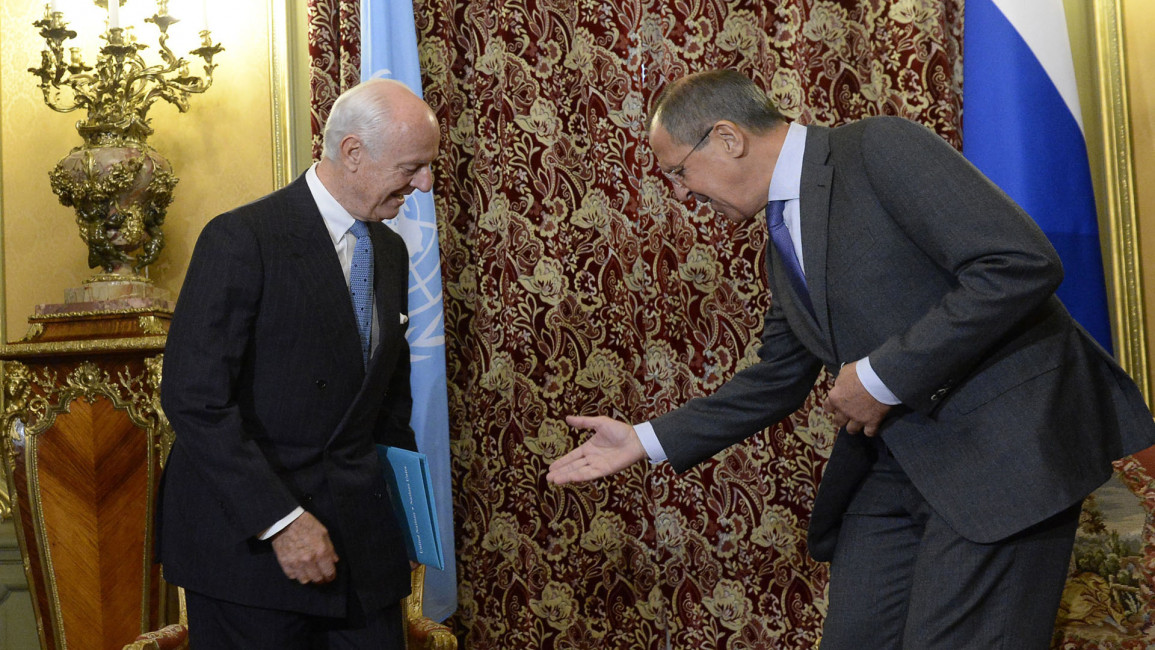
De Mistura's plan hits Syria's 'reset' button
International envoy Staffan de Mistura's plan to stop the fighting in certain areas of Syria has revived hopes among Syrians that this tentative start might lead to further progress towards a political settlement of the brutal civil war that has torn Syria apart over the past three years.
It is understandable that a plan like this would stir the imagination and the hopes of our people, under siege or in the areas outside the control of the regime of President Bashar al-Assad. It may give them some hope of salvation, at least from starvation, barrel bombs, incendiary bombs, death by snipers or other forms of violence.
However, the ceasefire plan, which starts in Aleppo, does not contain any prospect of a broader political solution. On the contrary, it was designed by the Russians and the Iranians, allies of the regime, specifically to help the regime. It will help the regime reap the fruits of the systematic starvation, subjugation, indiscriminate killings, mass displacement of population, and the obliteration of normal civilian life in the areas controlled by opposition fighters.
It could only ever mean that Syrians accept an end to the conflict without any change in the regime whose brutality and misrule led them to revolt in the first place. It allows Syrians to live without fear of dying from a barrel bomb, and to receive international aid, after they acknowledge and accept a political fait accompli.
A ceasefire in the regime's favour
| The Iranians know Assad need do no more than put the conflict on hold to survive and shore up his deteriorating situation. |
The Iranians leading military and political operations in Syria are aware battle fatigue has affected all sides, especially the regime. They know that Assad need do no more than put the conflict on hold to survive and shore up his deteriorating military and political situation.
To be sure, a ceasefire virtually without conditions - the one condition being that aid is allowed into besieged areas - would mean Assad is freed from military and international pressure, and his authority would be restored in the areas he controls. This ceasefire would also mean that the areas controlled by the opposition continue to be mired in chaos and plagued by conflict, begging for international aid.
Such a situation would not only ensure Assad's survival, which the Iranians want, but would also relieve the international community of its burden for the Syrian tragedy.
It would leave the Syrian people, who rose up against a murderous, oppressive regime, with little except for humanitarian aid. The aid the international community provided to opposition areas would allow people there to survive, but little by little they would have to deal with Damascus as the capital of the rump Syrian state, and the areas controlled by the divided opposition would increasingly become irrelevant and insignificant aberrations.
It is natural for Assad to be enthusiastic about such a scheme, which complements his brutal policies by cementing the de facto partition of the country between him and the opposition. Assad would keep the main part of the country, its resources and the symbols of the Syrian state, and leave the rest as a toxic gift for the opposition, to fight the Islamic State group (IS, formerly known as ISIS) on Damascus' behalf.
It is no coincidence that De Mistura chose Aleppo for his plan. Halting the fighting there would allow Assad's pro-Iranian regime to divert forces to recapture rebel strongholds in the Ghouta region near Damascus, and cleanse the areas he controls from the opposition once and for all.
This would be the best result Assad could expect to come from his policy of forging truces with fighters in besieged neighbourhoods and villages. This policy let Assad neutralise thousands of fighters and ease the burden on his forces, allowing him to bolster his position in Damascus, central Syria and the coast, areas that would be firmly incorporated into his rump state.
| By dividing Syria between the opposition, the Islamic State group and the regime, the plan would abort demands for democracy. |
De Mistura's project is a lifeline to Assad's vulnerable regime, and it comes at the right moment. It is the knockout blow his allies want to deal to the revolution and its goals.
Assad and the Iranians will hunker down in Damascus and its provinces and challenge the opposition in their bid to establish the democratic, pluralistic government the revolution fought for.
An interim solution
Contrary to what is claimed, De Mistura's project does not create the possibility of a real solution, a real settlement, or even further negotiations - let alone a political transition or a coalition government. By dividing Syria between the opposition, the Islamic State group and the regime, the plan would abort future negotiations and any demands for greater democracy, allowing each side to impose the system of government they want in their respective regions. This would effectively end Syria's existence as a state.
I do not believe that other states and the powers of the international system oppose this.
Many of them, including those who claim to be friends of the Syrian people, see this plan as the best way to evade responsibility for the Syrian crisis and the Syrian people. They might also see the presence of the Islamic State group in eastern Syria as the best way to shackle Sunni Muslims and drown them in a cycle of bloodshed and internal civil conflict.
Opinions expressed in this article remain those of the original author and do not necessarily reflect the opinions of al-Araby al-Jadeed, its editorial board or staff.
This is an edited translation from our Arabic edition.




